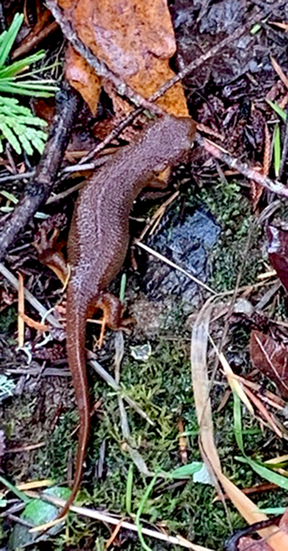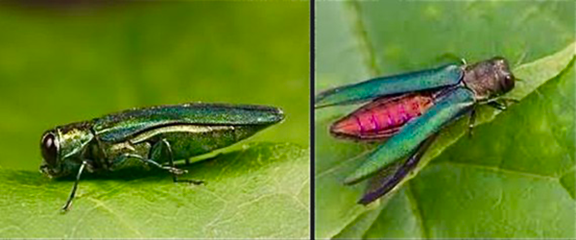The Nature of Cedar Mill

- Wetland Cleanup at Cedar Mill
- WashCo quarantine to slow the emerald ash borer
- Treekeepers of Washington County events
- Newts on the move
Wetland Cleanup at Cedar Mill
Thursday January 12, 9:30 am-12 pm, free and open to all ages, please RSVP here for details and meet up location
Join us for a chilly morning of hard work removing all kinds of trash—large and small, from this special ecosystem. There will be tires, wires, and bits of old appliances from the days before wetland protections went into place. Be sure to bring your binoculars too because this ecosystem is teeming with migrating ducks, foraging herons, and fishing raptors! Tools, gloves, and snacks are provided.
All the details including task lists, recommended equipment, weather forecast, and parking details will be included in the confirmation email that goes out to all the RSVP email addresses one week, and then again one day before the event. Please RSVP so we have a good idea of how many tools and pairs of gloves to bring on the day.
WashCo quarantine to slow the emerald ash borer

The Oregon Department of Agriculture (ODA) has adopted a temporary EAB quarantine to limit the movement of ash, olive, and white fringe tree materials from Washington County to slow the spread of EAB to unaffected locations in the state. This temporary quarantine will remain in effect until May 16, 2023. As more data becomes available, ODA will evaluate future quarantine parameters.
EAB is now considered the most destructive forest pest in North America, killing hundreds of millions of ash trees. The 1/2-inch beetle is often challenging to detect, especially in newly infested trees. Signs of infestation include thinning and yellowing leaves, bark splitting, D-shaped holes in the tree bark, and basal shoots.
The streamside areas of Cedar Mill have lots of ash trees. Keen-eyed neighbors walking our trails can be very helpful in preventing an infestation. Tualatin Soil & Water Conservation District will be working with ODA in our area. Here’s their informative page.
The Washington County EAB quarantine restricts the movement of several tree materials including but not limited to logs, green lumber, nursery stock, scion wood, bud wood, chips, mulch, stumps, roots, branches, and firewood of hardwood species. ODA is establishing several processing and disposal resources in the area to limit the movement of tree materials to within the quarantine area. For a list of disposal sites, and more information on EAB, please visit: ODA.direct/EAB.
OSU Extension Service has additional information here.

Treekeepers news and events
Treekeepers of Washington County is a grassroots organization of volunteers. We work to protect existing trees for the many benefits they provide by advocating for sustainable development in Washington County.
Sign our petition to request a countywide urban forestry program that would offset the negative impact of increased housing development on our tree canopy and the localized impact of climate change.
For more information, visit our website.
Treekeepers of Washington County events
How a Washington County Urban Forestry Program Can Save Our Trees
January 17, 6:30 pm, via zoom
Be part of our first-ever meeting for anyone interested in Washington County Trees! Scott Altenhoff, Oregon Department of Forestry’s Manager, Urban and Community Forestry Assistance Program, will be addressing best practices for urban forest planning, assessment, and management as well as for disaster prevention, response, and recovery. We hope to see you at this important event.
Register on the zoom page here.
Tree Walk: Learn to identify local trees
January 21, 1 pm, Jordan Woods Natural Area
Join Joanne and Susan on a 1.5 mile, soft-surface trail near Cedar Mill Creek to learn how to identify some of the most common conifers in our area: Douglas fir, Western red cedar, Grand fir, and Sequoia—and a few bonus trees including how to recognize some common native deciduous trees without their leaves. Bring your umbrellas and suitable clothing, as this walk takes place rain or shine. Learn more and register here.
Cedar Mill Tree Team
January 28, 10:30 am, Cedar Mill Community Library community room
Be part of our first planning session for anyone interested in trees in the Cedar Mill area. Come share your concerns and help make plans for solving problems in our neighborhood.
If you have been alarmed by how trees are disappearing to development, concerned about ivy strangling trees, wish you knew more about how to care for your trees, or are just plain curious, please join us to share what’s on your mind. We’ll be putting our heads together to come up with actions to improve our neighborhood.

Newts on the move
by Susan Mates
It may seem like the darkest, coldest part of the year to you, but to a Rough-skinned newt (Taricha granulosa) it’s time to wake up and go on the prowl for a mate. These prehistoric-looking amphibians may have been sleeping under a rotting log or a rock, but now they are creeping through the forest floor to the nearest wetland.
These stocky amphibians are a type of salamander. They have big heads and rounded snouts and are between four and eight inches long. Their backs may be light brown, olive, brick red, or brownish-black, but their undersides are a bright orange-yellow. When threatened, these newts arch their head toward their tail. That reveals their bright belly and the color signals danger since rough-skinned newts are the most poisonous amphibians in the Pacific Northwest. Just one newt contains enough poison to kill 25,000 mice! They are no threat to humans unless you eat them! If you touch a Rough-skinned newt, you should avoid touching your face and wash your hands afterward.
They’re not interested in you, though. They are single-mindedly headed for water where they will perform languorous gymnastics to entice a mate. The females lay their eggs and attach them to plants or other debris in the water. These rafts of eggs will hatch into gilled tadpoles that will metamorphosize into juveniles by later summer.

Besides helping to control insect populations such as mosquitoes, certain amphibians are indicators of wetland health. The Wetlands Conservancy collects annual data on urban amphibian populations throughout Washington County, including here at our Cedar Mill Wetland.
Trained community scientists don waders and slog through the wetlands in search of amphibian egg masses. You can join their ranks to get this insider view of the wetland world, where newts might swim right between your legs. Their next virtual training will be February 4, 2022. Learn more here, and sign up here. Or join the Wetlands Conservancy to clean up our Cedar Mill Wetland to make it a safe place for newts and other wetland creatures. See above for details.
So, keep your eyes open and tread gently as you walk paths near wetlands this time of year. You might be lucky enough to witness a determined newt looking for love.





